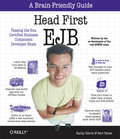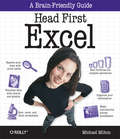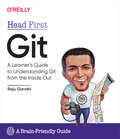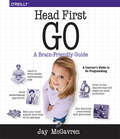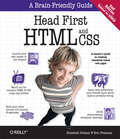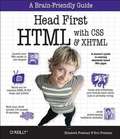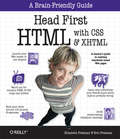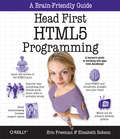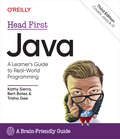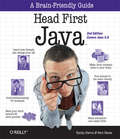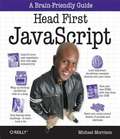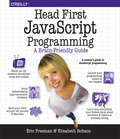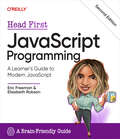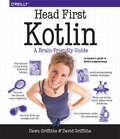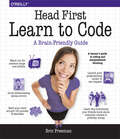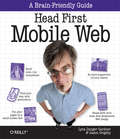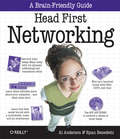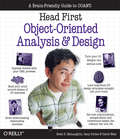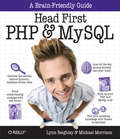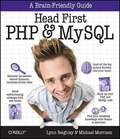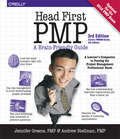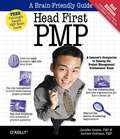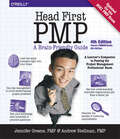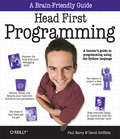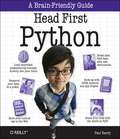- Table View
- List View
Head First EJB: Passing the Sun Certified Business Component Developer Exam (Head First)
by Bert Bates Kathy SierraWhat do Ford Financial, IBM, and Victoria's Secret have in common? Enterprise JavaBeans (EJB). As the industry standard for platform-independent reusable business components, EJB has just become Sun Microsystem's latest developer certification. Whether you want to be certifiable or just want to learn the technology inside and out, Head First EJB will get you there in the least painful way. And with the greatest understanding.You'll learn not just what the technology is, but more importantly, why it is, and what it is and isn't good for. You'll learn tricks and tips for EJB development, along with tricks and tips for passing this latest, very challenging Sun Certified Business Component Developer (SCBCD) exam. You'll learn how to think like a server. You'll learn how to think like a bean. And because this is a Head First book, you'll learn how to think about thinking.Co-author Kathy Sierra was one of Sun's first employees to teach brave, early adopter customers how to use EJB. She has the scars. But besides dragging you deep into EJB technology, Kathy and Bert will see you through your certification exam, if you decide to go for it. And nobody knows the certification like they do - they're co-developers of Sun's actual exam!As the second book in the Head First series, Head First EJB follows up the number one best-selling Java book in the US, Head First Java. Find out why reviewers are calling it a revolution in learning tough technical topics, and why Sun Chairman and CEO Scott McNealy says, "Java technology is everywhere...if you develop software and haven't learned Java, it's definitely time to dive in "Head First."And with Head First book, you don't even have to feel guilty about having fun while you're learning; it's all part of the learning theory. If the latest research in cognitive science, education, and neurobiology suggested that boring, dry, and excruciatingly painful was the best way to learn, we'd have done it. Thankfully, it's been shown that your brain has a sense of style, a sense of humour, and a darn good sense of what it likes and dislikes.In Head First EJB, you'll learn all about:Component-based and role-based development The architecture of EJB, distributed programming with RMIDeveloping and Deploying an EJB applicationThe Client View of a Session and Entity beanThe Session Bean Lifecycle and Component ContractThe Entity bean Lifecycle and Component ContractContainer-managed Persistence (CMP)Container-managed Relationships (CMR)EJB-QLTransactionsSecurityEJB ExceptionsThe Deployment DescriptorThe Enterprise Bean Environment in JNDIProgramming Restrictions and PortabilityThe book includes over 200 mock exam questions that match the tone, style, difficulty, and topics on the real SCBCD exam. See why Kathy and Bert are responsible for thousands of successful exam-passers--"The Sun certification exam was certainly no walk in the park, but Kathy's material allowed me to not only pass the exam, but Ace it!"--Mary Whetsel, Sr. Technology Specialist, Application Strategy and Integration, The St. Paul Companies"Kathy Sierra and Bert Bates are two of the few people in the world who can make complicated things seem damn simple, and as if that isn't enough, they can make boring things seem interesting."--Paul Wheaton, The Trail Boss, javaranch.com"Who better to write a Java study guide than Kathy Sierra, reigning queen of Java instruction? Kathy Sierra has done it again. Here is a study guide that almost guarantees you a certification!"--James Cubetta, Systems Engineer, SGI
Head First Excel: A learner's guide to spreadsheets
by Michael MiltonDo you use Excel for simple lists, but get confused and frustrated when it comes to actually doing something useful with all that data? Stop tearing your hair out: Head First Excel helps you painlessly move from spreadsheet dabbler to savvy user. Whether you're completely new to Excel or an experienced user looking to make the program work better for you, this book will help you incorporate Excel into every aspect of your workflow, from a scratch pad for data-based brainstorming to exploratory analysis with PivotTables, optimizing outcomes with Goal Seek, and presenting your conclusions with sophisticated data visualizations.Organize and clearly present information in a spreadsheetMake calculations across a number of worksheetsChange your point of view with sorting, zooming, and filteringManipulate numerical data to extract and use just what you needLeverage Excel as a grid-based layout programWrite formulas for optimal functionalityNest formulas for more complex operationsCreate sophisticated data visualizations with charts and graphsUse Goal Seek to optimize possible outcomes based on different assumptionsCreate summaries from large data sets for exploratory data analysis with PivotTablesWe think your time is too valuable to waste struggling with new concepts. Using the latest research in cognitive science and learning theory to craft a multi-sensory learning experience, Head First Excel uses a visually rich format designed for the way your brain works, rather than a text-heavy approach that will put you to sleep.
Head First Git: A Learner's Guide to Understanding Git from the Inside Out
by Raju GandhiWhat will you learn from this book?Many people who use Git rely on "recipes"--copying and pasting commands they find on the internet without really understanding how Git actually works. But what do you do if you find yourself in a tight spot? You can't simply wing it. With this unique hands-on guide, you'll learn the ways of Git and have fun while doing it. Raju Gandhi peels back the layers to reveal the simple yet powerful engine that powers Git, so you'll understand not just the how but the why. You'll master branches, merges, commit messages, search, utilities, and more; learn best practices for collaborative work; and unlock the full potential of Git.What's so special about this book?If you've read a Head First book, you know what to expect--a visually rich format designed for the way your brain works. If you haven't, you're in for a treat. With this book, you'll learn Git through a multisensory experience that engages your mind rather than a text-heavy approach that puts you to sleep.
Head First Go
by Jay McGavrenWhat will you learn from this book?Go makes it easy to build software that’s simple, reliable, and efficient. Andthis book makes it easy for programmers like you to get started. Googledesigned Go for high-performance networking and multiprocessing, but—like Python and JavaScript—the language is easy to read and use. With thispractical hands-on guide, you’ll learn how to write Go code using clearexamples that demonstrate the language in action. Best of all, you’ll understandthe conventions and techniques that employers want entry-level Godevelopers to know.Why does this book look so different?Based on the latest research in cognitive science and learning theory, HeadFirst Go uses a visually rich format to engage your mind rather than a textheavyapproach that puts you to sleep. Why waste your time struggling withnew concepts? This multisensory learning experience is designed for theway your brain really works.
Head First HTML and CSS: A Learner's Guide to Creating Standards-Based Web Pages (Oreilly And Associate Ser.)
by Eric Freeman Elisabeth RobsonTired of reading HTML books that only make sense after you're an expert? Then it's about time you picked up Head First HTML and really learned HTML. You want to learn HTML so you can finally create those web pages you've always wanted, so you can communicate more effectively with friends, family, fans, and fanatic customers. You also want to do it right so you can actually maintain and expand your web pages over time so they work in all browsers and mobile devices. Oh, and if you've never heard of CSS, that's okay--we won't tell anyone you're still partying like it's 1999--but if you're going to create web pages in the 21st century then you'll want to know and understand CSS.Learn the real secrets of creating web pages, and why everything your boss told you about HTML tables is probably wrong (and what to do instead). Most importantly, hold your own with your co-worker (and impress cocktail party guests) when he casually mentions how his HTML is now strict, and his CSS is in an external style sheet.With Head First HTML, you'll avoid the embarrassment of thinking web-safe colors still matter, and the foolishness of slipping a font tag into your pages. Best of all, you'll learn HTML and CSS in a way that won't put you to sleep. If you've read a Head First book, you know what to expect: a visually-rich format designed for the way your brain works. Using the latest research in neurobiology, cognitive science, and learning theory, this book will load HTML and CSS into your brain in a way that sticks.So what are you waiting for? Leave those other dusty books behind and come join us in Webville. Your tour is about to begin.
Head First HTML with CSS & XHTML
by Elisabeth Freeman Eric FreemanTired of reading HTML books that only make sense after you're an expert? Then it's about time you picked up Head First HTML with CSS & XHTML and really learned HTML. You want to learn HTML so you can finally create those Web pages you've always wanted, so you can communicate more effectively with friends, family, fans and fanatic customers. You also want to do it right so you can actually maintain and expand your Web pages over time, and so your Web pages work in all the browsers and mobile devices out there. Oh, and if you've never heard of CSS, that's okay - we won't tell anyone you're still partying like it's 1999 - but if you're going to create Web pages in the 21st century then you'll want to know and understand CSS. Learn the real secrets of creating Web pages, and why everything your boss told you about HTML tables is probably wrong (and what to do instead). Most importantly, hold your own with your co-worker (and impress cocktail party guests) when he casually mentions how his HTML is now strict, and his CSS is in an external style sheet. With Head First HTML with CSS & XHTML, you'll avoid the embarrassment of thinking Web-safe colors still matter, and the foolishness of slipping a font tag into your pages. Best of all, you'll learn HTML and CSS in a way that won't put you to sleep. If you've read a Head First book, you know what to expect: a visually-rich format designed for the way your brain works. Using the latest research in neurobiology, cognitive science, and learning theory, this book will load HTML, CSS, and XHTML into your brain in a way that sticks. So what are you waiting for? Leave those other dusty books behind and come join us in Webville. Your tour is about to begin. "Elegant design is at the core of every chapter here, each concept conveyed with equal doses of pragmatism and wit." --Ken Goldstein, Executive Vice President, Disney Online "This book is a thoroughly modern introduction to forward-looking practices in web page markup and presentation." --Danny Goodman, author of Dynamic HTML: The Definitive Guide "What used to be a long trial and error learning process has now been reduced neatly into an engaging paperback." --Mike Davidson, CEO, Newsvine, Inc. "I love Head First HTML with CSS & XHTML --it teaches you everything you need to learn in a 'fun coated' format!" --Sally Applin, UI Designer and Artist "I haven't had as much fun reading a book (other than Harry Potter) in years. And your book finally helped me break out of my hapless so-last-century way of creating web pages." --Professor David M. Arnow, Department of Computer and Information Science, Brooklyn College "If you've ever had a family member who wanted you to design a website for them, buy them Head First HTML with CSS and XHTML. If you've ever asked a family member to design you a web site, buy this book. If you've ever bought an HTML book and ended up using it to level your desk, or for kindling on a cold winter day, buy this book. This is the book you've been waiting for. This is the learning system you've been waiting for." --Warren Kelly, Blogcritics.org
Head First HTML with CSS & XHTML
by Eric Freeman Elisabeth RobsonTired of reading HTML books that only make sense after you're an expert? Then it's about time you picked up Head First HTML with CSS & XHTML and really learned HTML. You want to learn HTML so you can finally create those web pages you've always wanted, so you can communicate more effectively with friends, family, fans, and fanatic customers. You also want to do it right so you can actually maintain and expand your Web pages over time, and so your web pages work in all the browsers and mobile devices out there. Oh, and if you've never heard of CSS, that's okay - we won't tell anyone you're still partying like it's 1999 - but if you're going to create Web pages in the 21st century then you'll want to know and understand CSS. Learn the real secrets of creating Web pages, and why everything your boss told you about HTML tables is probably wrong (and what to do instead). Most importantly, hold your own with your co-worker (and impress cocktail party guests) when he casually mentions how his HTML is now strict, and his CSS is in an external style sheet. With Head First HTML with CSS & XHTML, you'll avoid the embarrassment of thinking web-safe colors still matter, and the foolishness of slipping a font tag into your pages. Best of all, you'll learn HTML and CSS in a way that won't put you to sleep. If you've read a Head First book, you know what to expect: a visually-rich format designed for the way your brain works. Using the latest research in neurobiology, cognitive science, and learning theory, this book will load HTML, CSS, and XHTML into your brain in a way that sticks. So what are you waiting for? Leave those other dusty books behind and come join us in Webville. Your tour is about to begin. "Elegant design is at the core of every chapter here, each concept conveyed with equal doses of pragmatism and wit." --Ken Goldstein, Executive Vice President, Disney Online "This book is a thoroughly modern introduction to forward-looking practices in web page markup and presentation." --Danny Goodman, author of Dynamic HTML: The Definitive Guide "What used to be a long trial and error learning process has now been reduced neatly into an engaging paperback." --Mike Davidson, CEO, Newsvine, Inc. "I love Head First HTML with CSS & XHTML--it teaches you everything you need to learn in a 'fun coated' format!" --Sally Applin, UI Designer and Artist "I haven't had as much fun reading a book (other than Harry Potter) in years. And your book finally helped me break out of my hapless so-last-century way of creating web pages." --Professor David M. Arnow, Department of Computer and Information Science, Brooklyn College "If you've ever had a family member who wanted you to design a website for them, buy them Head First HTML with CSS and XHTML. If you've ever asked a family member to design you a web site, buy this book. If you've ever bought an HTML book and ended up using it to level your desk, or for kindling on a cold winter day, buy this book. This is the book you've been waiting for. This is the learning system you've been waiting for." --Warren Kelly, Blogcritics.org
Head First HTML5 Programming: Building Web Apps with JavaScript
by Eric Freeman Elisabeth RobsonHTML has been on a wild ride. Sure, HTML started as a mere markup language, but more recently HTML’s put on some major muscle. Now we’ve got a language tuned for building web applications with Web storage, 2D drawing, offline support, sockets and threads, and more. And to speak this language you’ve got to go beyond HTML5 markup and into the world of the DOM, events, and JavaScript APIs.Now you probably already know all about HTML markup (otherwise known as structure) and you know all aboutCSS style (presentation), but what you’ve been missing is JavaScript (behavior). If all you know about are structure and presentation, you can create some great looking pages, but they’re still just pages. When you add behavior with JavaScript, you can create an interactive experience; even better, you can create full blown web applications.Head First HTML5 Programming is your ultimate tour guide to creating web applications with HTML5 and JavaScript, and we give you everything you need to know to build them, including: how to add interactivity to your pages, how to communicate with the world of Web services, and how to use the great new APIs being developed for HTML5.Here are just some of the things you’ll learn in Head First HTML5 Programing:Learn how to make your pages truly interactive by using the power of the DOM.Finally understand how JavaScript works and take yourself from novice to well-informed in just a few chapters.Learn how JavaScript APIs fit into the HTML5 ecosystem, and how to use any API in your web pages.Use the Geolocation API to know where your users are.Bring out your inner artist with Canvas, HTML5’s new 2D drawing surface.Go beyond just plugging a video into your pages, and create custom video experiences.Learn the secret to grabbing five megabytes of storage in every user’s browser.Improve your page’s responsiveness and performance with Web workers.And much more.
Head First Java: A Brain-Friendly Guide
by Bert Bates Kathy Sierra Trisha GeeWhat will you learn from this book?Head First Java is a complete learning experience in Java and object-oriented programming. With this book, you'll learn the Java language with a unique method that goes beyond how-to manuals and helps you become a great programmer. Through puzzles, mysteries, and soul-searching interviews with famous Java objects, you'll quickly get up to speed on Java's fundamentals and advanced topics including lambdas, streams, generics, threading, networking, and the dreaded desktop GUI. If you have experience with another programming language, Head First Java will engage your brain with more modern approaches to coding--the sleeker, faster, and easier to read, write, and maintain Java of today.What's so special about this book?If you've read a Head First book, you know what to expect--a visually rich format designed for the way your brain works. If you haven't, you're in for a treat. With Head First Java, you'll learn Java through a multisensory experience that engages your mind, rather than by means of a text-heavy approach that puts you to sleep.
Head First Java: A Brain-Friendly Guide (Head First)
by Bert Bates Kathy SierraLearning a complex new language is no easy task especially when it s an object-oriented computer programming language like Java. You might think the problem is your brain. It seems to have a mind of its own, a mind that doesn't always want to take in the dry, technical stuff you're forced to study. The fact is your brain craves novelty. It's constantly searching, scanning, waiting for something unusual to happen. After all, that's the way it was built to help you stay alive. It takes all the routine, ordinary, dull stuff and filters it to the background so it won't interfere with your brain's real work--recording things that matter. How does your brain know what matters? It's like the creators of the Head First approach say, suppose you're out for a hike and a tiger jumps in front of you, what happens in your brain? Neurons fire. Emotions crank up. Chemicals surge. That's how your brain knows. And that's how your brain will learn Java. Head First Java combines puzzles, strong visuals, mysteries, and soul-searching interviews with famous Java objects to engage you in many different ways. It's fast, it's fun, and it's effective. And, despite its playful appearance, Head First Java is serious stuff: a complete introduction to object-oriented programming and Java. You'll learn everything from the fundamentals to advanced topics, including threads, network sockets, and distributed programming with RMI. And the new. second edition focuses on Java 5.0, the latest version of the Java language and development platform. Because Java 5.0 is a major update to the platform, with deep, code-level changes, even more careful study and implementation is required. So learning the Head First way is more important than ever. If you've read a Head First book, you know what to expect--a visually rich format designed for the way your brain works. If you haven't, you're in for a treat. You'll see why people say it's unlike any other Java book you've ever read. By exploiting how your brain works, Head First Java compresses the time it takes to learn and retain--complex information. Its unique approach not only shows you what you need to know about Java syntax, it teaches you to think like a Java programmer. If you want to be bored, buy some other book. But if you want to understand Java, this book's for you.
Head First JavaScript
by Michael MorrisonSo you're ready to make the leap from writing HTML and CSS web pages to creating dynamic web applications. You want to take your web skills to the next level. And you're finally ready to add "programmer" to the resume. It sounds like you're ready to learn the Web's hottest programming language: JavaScript. Head First JavaScript is your ticket to going beyond copying and pasting the code from someone else's web site, and writing your own interactive web pages. With Head First JavaScript, you learn: The basics of programming, from variables to types to looping How the web browser runs your code, and how you can talk to the browser with your code Why you'll never have to worry about casting, overloading, or polymorphism when you're writing JavaScript code How to use the Document Object Model to change your web pages without making your users click buttons If you've ever read a Head First book, you know what to expect -- a visually rich format designed for the way your brain works. Head First JavaScript is no exception. It starts where HTML and CSS leave off, and takes you through your first program into more complex programming concepts -- like working directly with the web browser's object model and writing code that works on all modern browsers. Don't be intimidated if you've never written a line of code before! In typical Head First style, Head First JavaScript doesn't skip steps, and we're not interested in having you cut and paste code. You'll learn JavaScript, understand it, and have a blast along the way. So get ready... dynamic and exciting web pages are just pages away.
Head First JavaScript Programming
by Elisabeth Robson Eric T. FreemanWhat will you learn from this book? This brain-friendly guide teaches you everything from JavaScript language fundamentals to advanced topics, including objects, functions, and the browser's document object model. You won't just be reading--you'll be playing games, solving puzzles, pondering mysteries, and interacting with JavaScript in ways you never imagined. And you'll write real code, lots of it, so you can start building your own web applications. Prepare to open your mind as you learn (and nail) key topics including:<P> The inner details of JavaScript<P> How JavaScript works with the browser<P> The secrets of JavaScript types<P> Using arrays<P> The power of functions<P> How to work with objects<P> Making use of prototypes<P> Understanding closures<P> Writing and testing applications<P> What's so special about this book?<P> We think your time is too valuable to waste struggling with new concepts. Using the latest research in cognitive science and learning theory to craft a multi-sensory learning experience, Head First JavaScript Programming uses a visually rich format designed for the way your brain works, not a text-heavy approach that puts you to sleep.<p> Advisory: Bookshare has learned that this book offers only partial accessibility. We have kept it in the collection because it is useful for some of our members. To explore further access options with us, please contact us through the Book Quality link on the right sidebar. Benetech is actively working on projects to improve accessibility issues such as these.
Head First JavaScript Programming: A Learner's Guide to Modern JavaScript
by Eric Freeman Elisabeth RobsonWhat will you learn from this book?The new edition of this brain-friendly guide takes you through a comprehensive journey into modern JavaScript, covering everything from core language fundamentals to today's cutting-edge features. You'll dive into the nuances of JavaScript types and the unparalleled flexibility of its functions. You'll also learn how to expertly navigate classes and objects, and finally understand closures. But that's just the beginning. You'll also get hands-on with the browser's document object model (DOM), engaging with JavaScript in exciting ways. You won't just be reading—you'll be playing games, solving puzzles, pondering mysteries, and interacting with JavaScript as never before. And you'll write real code, lots of it, so you can start building your own applications.What's so special about this book?If you've read a Head First book, you know what to expect: a visually rich format designed for the way your brain works. If you haven't, you're in for a treat. With this book, you'll learn JavaScript through a multisensory experience that engages your mind—rather than a text-heavy approach that puts you to sleep.
Head First Kotlin: A Brain-Friendly Guide
by Dawn Griffiths David GriffithsWhat will you learn from this book?Head First Kotlin is a complete introduction to coding in Kotlin. This hands-on book helps you learn the Kotlin language with a unique method that goes beyond syntax and how-to manuals and teaches you how to think like a great Kotlin developer. You’ll learn everything from language fundamentals to collections, generics, lambdas, and higher-order functions. Along the way, you’ll get to play with both object-oriented and functional programming. If you want to really understand Kotlin, this is the book for you.Why does this book look so different?Based on the latest research in cognitive science and learning theory, Head First Kotlin uses a visually rich format to engage your mind rather than a text-heavy approach that puts you to sleep. Why waste your time struggling with new concepts? This multisensory learning experience is designed for the way your brain really works.
Head First Learn to Code: A Learner's Guide to Coding and Computational Thinking
by Eric FreemanWhat will you learn from this book?Itâ??s no secret the world around you is becoming more connected, more configurable, more programmable, more computational. You can remain a passive participant, or you can learn to code. With Head First Learn to Code youâ??ll learn how to think computationally and how to write code to make your computer, mobile device, or anything with a CPU do things for you. Using the Python programming language, youâ??ll learn step by step the core concepts of programming as well as many fundamental topics from computer science, such as data structures, storage, abstraction, recursion, and modularity.Why does this book look so different?Based on the latest research in cognitive science and learning theory, Head First Learn to Code uses a visually rich format to engage your mind, rather than a text-heavy approach that puts you to sleep. Why waste your time struggling with new concepts? This multi-sensory learning experience is designed for the way your brain really works.
Head First Mobile Web
by Lyza Danger Gardner Jason GrigsbyMobile web usage is exploding. Soon, more web browsing will take place on phones and tablets than PCs. Your business needs a mobile strategy, but where do you start? Head First Mobile Web shows how to use the web tech- nology you’re already familiar with to make sites and apps that work on any device of any size. Put your JavaScript, CSS media query, and HTML5 skills to work, and then optimize your site to perform its best in the demanding mobile market. Along the way, you’ll discover how to adapt your business strategy to target specific devices.Navigate the increasingly complex mobile landscapeTake both technical and strategic approaches to mobile web designUse the latest development techniques—including Responsive Web Design and server-side device detection with WURFLLearn quickly through images, puzzles, stories, and quizzesWe think your time is too valuable to waste struggling with new concepts. Using the latest research in cognitive science and learning theory to craft a multi-sensory learning experience, Head First Mobile Web uses a visually rich format designed for the way your brain works, not a text-heavy approach that puts you to sleep.
Head First Networking: A Brain-Friendly Guide (Head First)
by Ryan Benedetti Al Anderson<p>Frustrated with networking books so chock full of acronyms that your brain goes into sleep mode? <em>Head First Networking's</em> unique, visually rich format provides a task-based approach to computer networking that makes it easy to get your brain engaged. You'll learn networking concepts by tying them to on-the-job tasks, blending practice and theory in a way that only Head First can. Then you'll practice what you've learned, with nearly one hundred exercises, questions, sample problems, and projects.</p>
Head First Object-Oriented Analysis and Design: A Brain Friendly Guide to OOA&D (Head First Ser.)
by Gary Pollice David West Brett McLaughlin"Head First Object Oriented Analysis and Design is a refreshing look at subject of OOAD. What sets this book apart is its focus on learning. The authors have made the content of OOAD accessible, usable for the practitioner."Ivar Jacobson, Ivar Jacobson Consulting"I just finished reading HF OOA&D and I loved it! The thing I liked most about this book was its focus on why we do OOA&D-to write great software!"Kyle Brown, Distinguished Engineer, IBM"Hidden behind the funny pictures and crazy fonts is a serious, intelligent, extremely well-crafted presentation of OO Analysis and Design. As I read the book, I felt like I was looking over the shoulder of an expert designer who was explaining to me what issues were important at each step, and why."Edward Sciore,Associate Professor, Computer Science Department, Boston CollegeTired of reading Object Oriented Analysis and Design books that only makes sense after you're an expert? You've heard OOA&D can help you write great software every time-software that makes your boss happy, your customers satisfied and gives you more time to do what makes you happy.But how?Head First Object-Oriented Analysis & Design shows you how to analyze, design, and write serious object-oriented software: software that's easy to reuse, maintain, and extend; software that doesn't hurt your head; software that lets you add new features without breaking the old ones. Inside you will learn how to:Use OO principles like encapsulation and delegation to build applications that are flexibleApply the Open-Closed Principle (OCP) and the Single Responsibility Principle (SRP) to promote reuse of your codeLeverage the power of design patterns to solve your problems more efficientlyUse UML, use cases, and diagrams to ensure that all stakeholders arecommunicating clearly to help you deliver the right software that meets everyone's needs.By exploiting how your brain works, Head First Object-Oriented Analysis & Design compresses the time it takes to learn and retain complex information. Expect to have fun, expect to learn, expect to be writing great software consistently by the time you're finished reading this!
Head First PHP & MySQL: A Brain-Friendly Guide (Head First)
by Michael Morrison Lynn BeighleyIf you're ready to create web pages more complex than those you can build with HTML and CSS, Head First PHP & MySQL is the ultimate learning guide to building dynamic, database-driven websites using PHP and MySQL. Packed with real-world examples, this book teaches you all the essentials of server-side programming, from the fundamentals of PHP and MySQL coding to advanced topics such as form validation, session IDs, cookies, database queries and joins, file I/O operations, content management, and more.Head First PHP & MySQL offers the same visually rich format that's turned every title in the Head First series into a bestseller, with plenty of exercises, quizzes, puzzles, and other interactive features to help you retain what you've learned.Use PHP to transform static HTML pages into dynamic web sitesCreate and populate your own MySQL database tables, and work with data stored in filesPerform sophisticated MySQL queries with joins, and refine your results with LIMIT and ORDER BYUse cookies and sessions to track visitors' login information and personalize the site for usersProtect your data from SQL injection attacksUse regular expressions to validate information on formsDynamically display text based on session info and create images on the flyPull syndicated data from other sites using PHP and XMLThroughout the book, you'll build sophisticated examples -- including a mailing list, a job board, and an online dating site -- to help you learn how to harness the power of PHP and MySQL in a variety of contexts. If you're ready to build a truly dynamic website, Head First PHP & MySQL is the ideal way to get going.
Head First PHP and MySQL
by Michael Morrison Lynn BeighleyIf you're ready to create web pages more complex than those you can build with HTML and CSS, Head First PHP & MySQL is the ultimate learning guide to building dynamic, database-driven websites using PHP and MySQL. Packed with real-world examples, this book teaches you all the essentials of server-side programming, from the fundamentals of PHP and MySQL coding to advanced topics such as form validation, session IDs, cookies, database queries and joins, file I/O operations, content management, and more. Head First PHP & MySQL offers the same visually rich format that's turned every title in the Head First series into a bestseller, with plenty of exercises, quizzes, puzzles, and other interactive features to help you retain what you've learned. Use PHP to transform static HTML pages into dynamic web sites Create and populate your own MySQL database tables, and work with data stored in files Perform sophisticated MySQL queries with joins, and refine your results with LIMIT and ORDER BY Use cookies and sessions to track visitors' login information and personalize the site for users Protect your data from SQL injection attacks Use regular expressions to validate information on forms Dynamically display text based on session info and create images on the fly Pull syndicated data from other sites using PHP and XML Throughout the book, you'll build sophisticated examples -- including a mailing list, a job board, and an online dating site -- to help you learn how to harness the power of PHP and MySQL in a variety of contexts. If you're ready to build a truly dynamic website, Head First PHP & MySQL is the ideal way to get going.
Head First PMP
by Jennifer Greene Andrew StellmanLearn the latest principles and certification objectives in The PMBOK Guide, Fourth Edition, in a unique and inspiring way with Head First PMP . The second edition of this book helps you prepare for the PMP certification exam using a visually rich format designed for the way your brain works. You'll find a full-length sample exam included inside the book. More than just proof of passing a test, a PMP certification means that you have the knowledge to solve most common project problems. But studying for a difficult four-hour exam on project management isn't easy, even for experienced project managers. Drawing on the latest research in neurobiology, cognitive science, and learning theory, Head First PMP offers you a multi-sensory experience that helps the material stick, not a text-heavy approach that puts you to sleep. This book will help you:Learn PMP's underlying concepts to help you understand the PMBOK principles and pass the certification exam with flying colors Get 100% coverage of the latest principles and certification objectives in The PMBOK Guide, Fourth Edition, including two new processes: Collect Requirements and Identify Stakeholders Make use of a thorough and effective preparation guide with hundreds of practice questions and exam strategies Explore the material through puzzles, games, problems, and exercises that make learning easy and entertainingHead First PMP puts project management principles into context to help you understand, remember, and apply them -- not just on the exam, but also on the job.
Head First PMP: A Brain-Friendly Guide to Passing the Project Management Professional Exam (Head First)
by Jennifer Greene Andrew StellmanLearn the latest principles and certification objectives in The PMBOK Guide, Fourth Edition, in a unique and inspiring way with Head First PMP . The second edition of this book helps you prepare for the PMP certification exam using a visually rich format designed for the way your brain works. You'll find a full-length sample exam included inside the book.More than just proof of passing a test, a PMP certification means that you have the knowledge to solve most common project problems. But studying for a difficult four-hour exam on project management isn't easy, even for experienced project managers. Drawing on the latest research in neurobiology, cognitive science, and learning theory, Head First PMP offers you a multi-sensory experience that helps the material stick, not a text-heavy approach that puts you to sleep. This book will help you:Learn PMP's underlying concepts to help you understand the PMBOK principles and pass the certification exam with flying colorsGet 100% coverage of the latest principles and certification objectives in The PMBOK Guide, Fourth Edition, including two new processes: Collect Requirements and Identify StakeholdersMake use of a thorough and effective preparation guide with hundreds of practice questions and exam strategiesExplore the material through puzzles, games, problems, and exercises that make learning easy and entertainingHead First PMP puts project management principles into context to help you understand, remember, and apply them -- not just on the exam, but also on the job.
Head First PMP: A Learner's Companion to Passing the Project Management Professional Exam (Head First Ser.)
by Jennifer Greene Andrew StellmanNow updated for the 2021 PMP Exam What will you learn from this book?Head First PMP teaches you the latest principles and certification objectives in The PMBOK® Guide in a unique and inspiring way. This updated fourth edition takes you beyond specific questions and answers with a unique visual format that helps you grasp the big picture of project management. By putting PMP concepts into context, you'll be able to understand, remember, and apply them--not just on the exam, but on the job. No wonder so many people have used Head First PMP as their sole source for passing the PMP exam.This book will help you:Learn PMP's underlying concepts to help you understand the PMBOK principles and pass the certification exam with flying colorsGet 100% coverage of the latest principles and certification objectives in The PMBOK® Guide, Sixth EditionMake use of a thorough and effective preparation guide with hundreds of practice questions and exam strategiesExplore the material through puzzles, games, problems, and exercises that make learning easy and entertainingWhy does this book look so different?Based on the latest research in cognitive science and learning theory, Head First PMP uses a visually rich format to engage your mind, rather than a text-heavy approach that puts you to sleep. Why waste your time struggling with new concepts? This multi-sensory learning experience is designed for the way your brain really works.
Head First Programming: A learner's guide to programming using the Python language (O'reilly Ser.)
by David Griffiths Paul BarryLooking for a reliable way to learn how to program on your own, without being overwhelmed by confusing concepts? Head First Programming introduces the core concepts of writing computer programs -- variables, decisions, loops, functions, and objects -- which apply regardless of the programming language. This book offers concrete examples and exercises in the dynamic and versatile Python language to demonstrate and reinforce these concepts. Learn the basic tools to start writing the programs that interest you, and get a better understanding of what software can (and cannot) do. When you're finished, you'll have the necessary foundation to learn any programming language or tackle any software project you choose.With a focus on programming concepts, this book teaches you how to:Understand the core features of all programming languages, including: variables, statements, decisions, loops, expressions, and operatorsReuse code with functionsUse library code to save time and effortSelect the best data structure to manage complex dataWrite programs that talk to the WebShare your data with other programsWrite programs that test themselves and help you avoid embarrassing coding errorsWe think your time is too valuable to waste struggling with new concepts. Using the latest research in cognitive science and learning theory to craft a multi-sensory learning experience, Head First Programming uses a visually rich format designed for the way your brain works, not a text-heavy approach that puts you to sleep.
Head First Python
by Paul BarryHead First Python helps students learn programming skills quickly with engaging images, puzzles, stories, and quizzes that are proven to stimulate learning and retention.
